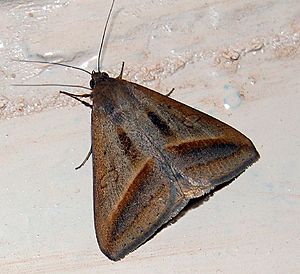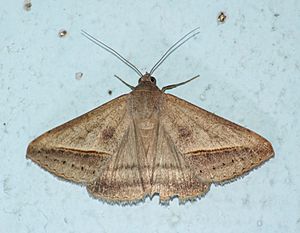Sugarcane looper facts for kids
Quick facts for kids Sugarcane looper |
|
|---|---|
 |
|
| Scientific classification | |
| Synonyms | |
|
The Mocis frugalis, also known as the sugarcane looper, is a type of moth. It belongs to the Erebidae family. A scientist named Johan Christian Fabricius first described this species in 1775. You can find this moth in many parts of the world. This includes countries like India, Sri Lanka, and various places in West Africa. It also lives in other parts of Asia. Adult sugarcane loopers can pierce fruit. They are considered a major pest for many crops.
Contents
What Does the Sugarcane Looper Look Like?

The sugarcane looper moth has a wingspan of about 36 to 50 millimeters (about 1.4 to 2 inches). Male moths have long, thick hairs on their back legs. Their bodies are usually a grey-brown color.
Forewings and Hindwings
The front wings (forewings) have a dark, blurry mark. This mark is found above the middle of a specific wing vein. There is also a slanted line that is light on the inside and reddish-brown on the outside. You might also see a row of small black spots near the edge of the wing. Some moths have a black spot near the inner edge of the forewing. The back wings (hindwings) have two lines. One is a postmedial line, and the other is a blurry submarginal line.
The Sugarcane Looper's Life Cycle
The young sugarcane looper is called a larva. It looks like a caterpillar. These larvae are pale yellowish-brown. They have darker lines along their bodies. There are two lines on their back. They also have a row of greenish spots along their sides. The fourth and fifth body parts of the larva have black edges.
What Do They Eat?
Sugarcane looper larvae eat many different plants. These include plants from the Zingiberaceae family. They also feed on grasses like Andropogon, Eleusine, Oryza (rice), Panicum, Paspalum, Saccharum (sugarcane), Sorghum, and Zea (corn). Other plants they eat are Typhonium, Cyperus, Glycine (soybeans), Medicago (alfalfa), and Vigna (beans).
Eggs
The eggs of the sugarcane looper are dark green. They often have dark purple blotches on them.
Why is the Sugarcane Looper a Pest?
The adult sugarcane looper moth is known as a fruit piercer. This means it can make holes in fruits to feed. This action can damage crops. Because of this, the sugarcane looper is considered a major pest in farming areas where it lives. It can cause problems for farmers by harming their plants and fruits.

